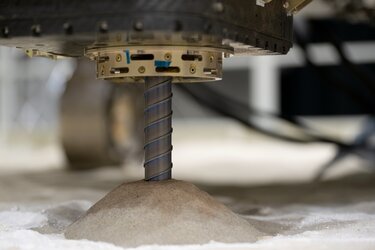
ExoMars deep drilling success on Earth
ESA’s Rosalind Franklin twin rover on Earth has drilled down and extracted samples 1.7 metres into the ground – much deeper than any other martian rover has ever attempted.
The first samples have been collected as part of a series of tests at the Mars Terrain Simulator at the ALTEC premises in Turin, Italy. The replica, also known as the Ground Test Model, is fully representative of the rover set to land on Mars.
The Rosalind Franklin rover is designed to drill deep enough, up to two metres, to get access to well-preserved organic material from four billion years ago, when conditions on the surface of Mars were more like those on infant Earth.
Rosalind Franklin’s twin has been drilling into a well filled with a variety of rocks and soil layers. The first sample was taken from a block of cemented clay of medium hardness.
Drilling took place on a dedicated platform tilted at seven degrees to simulate the collection of a sample in a non-vertical position. The drill acquired the sample in the shape of a pellet of about 1 cm in diameter.
Rosalind Franklin’s drill retains the sample with a shutter that prevents it from dropping out during retrieval. Once captured, the drill brings the sample to the surface and delivers it to the laboratory inside the rover.
With the drill completely retracted, the rock is dropped into a drawer at the front of the rover, which then withdraws and deposits the sample into a crushing station. The resulting powder is distributed to ovens and containers designed to perform the scientific analysis on Mars.
The drill was developed by Leonardo, while Thales Alenia Space is the prime contractor for ExoMars 2022. The ExoMars programme is a joint endeavour between ESA and Roscosmos.






